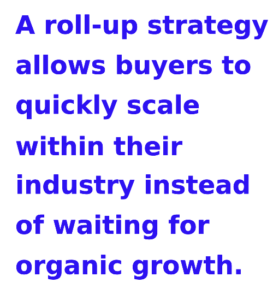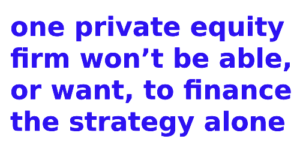How Industry Rollups Offer New Ways For Acquirers To Create Value in M&A

Industry rollups offer a new way for acquirers to create value in M&A. A rollup is a type of consolidation where a holding company acquires multiple smaller companies in the same industry. This can be a very effective strategy for creating a larger, more efficient, and more competitive company.
competitive company.
There are several benefits to industry rollups for both acquirers and target companies.
For acquirers, rollups can help them to:
• Achieve economies of scale: By combining multiple smaller companies, acquirers can reduce costs and improve efficiency. For example, they may be able to negotiate better prices with suppliers or reduce administrative costs. Typically strategic global acquirers are more skilful in getting more synergies out of their acquisitions as opposed to PE.
• Gain market share: Rollups can help acquirers quickly gain market share in a new industry or geographic region.
• Expand product offerings: By acquiring companies with complementary products and services, acquirers can expand their own product offerings and become more one-stop shops for their customers. Of course, this strategy has to be balanced with the need for a certain business model to be kept exclusive and not be melted with others.
• Improve operational efficiency: Rollups can help acquirers improve operational efficiency by implementing best practices across their portfolio companies.
For target companies, rollups can provide:
• Access to capital: acquirers often have access to significant capital, which can help target companies to grow and expand their businesses.
• Expertise and resources: acquirers can also provide target companies with access to expertise and resources that they may not have on their own. For example, they may be able to help target companies with marketing, sales funnels, talent and technology.
• Exit opportunities: Rollups can provide target companies with a clear exit path for their shareholders. This sort of acquirer typically has a goal of eventually selling the combined company to a more significant buyer or taking it public.
Acquirers can create value in industry rollups in many ways, including:
- Economies of scale: As mentioned above, rollups can help acquirers to achieve economies of scale. This can be done through various measures, such as centralising purchasing, streamlining operations, and eliminating redundant staff.
- Synergies: Rollups can also create value through synergies. This can include things like cross-selling products and services, combining marketing and sales efforts, and sharing resources.
- Operational improvements: Acquirers can also create value by implementing operational improvements at their target companies. This could involve things like improving customer service, reducing costs, or developing new products and services.
- Financial engineering: Acquirers can also create value through financial engineering. This could involve things like using debt to finance acquisitions, restructuring the capital structure of the combined company, or selling off non-core assets.
- Focus on the right industry: Acquirers should carefully select the industry in which they want to roll up companies. It is important to choose an industry that is fragmented and has the potential for consolidation.
- Identify the right targets: Acquirers should also carefully select the target companies. It is important to choose companies that are well-managed and have a strong track record of profitability.
- Have a clear integration plan: Acquirers should have a clear plan for how they will integrate the target companies into the combined business. This plan should include a strategy for achieving economies of scale, synergies, and operational improvements.
- Manage the cultural integration: Acquirers should also carefully manage the cultural integration of the target companies. It is important to create a unified culture for the combined business that is focused on customer satisfaction and performance.
The best industries for a roll-up strategy are those that are:
- Highly fragmented with no market leader, such as emerging sub-industries in technology and software, so they can quickly realise the benefits of being a larger organisation.
- Common and necessary across regions so that there will be many target businesses available at lower purchase price values. This is especially true in a hot M&A market where individual multiples are at record highs. Often, these industries have a lower barrier to entry but need the buying power and sophistication of a larger organisation.
- Simply organised so they are easier to integrate into the larger platform with shared and automated overhead.
- Forecasting positive economic growth so investors can realise the benefits of size in a growing industry.
Get ready as the process is not a red carpet.
 The process of completing a roll-up merger strategy will differ in its details depending on the nature of the industry and the motive of the company pursuing a roll-up strategy. However, the general process remains the same. Over time, one company in an industry acquires other smaller companies. This strategy might take place over many years or happen relatively quickly, depending on the nature of the industry.
The process of completing a roll-up merger strategy will differ in its details depending on the nature of the industry and the motive of the company pursuing a roll-up strategy. However, the general process remains the same. Over time, one company in an industry acquires other smaller companies. This strategy might take place over many years or happen relatively quickly, depending on the nature of the industry.
The most difficult part of a roll-up acquisition strategy is finding the necessary capital to fund the various acquisitions. A company can fund these acquisitions with its own capital by taking on additional debt or by obtaining funds from private or public equity. In many cases, a roll-up strategy requires more capital than a company has on hand, so it will need funding from other sources. One of the most common places for roll-ups to find capital is in the PE market.
Suppose a company decides to use funding from a private equity company to pursue a roll-up acquisition strategy. In that case, it should find a PE that specialises in this type of merger. Roll-up transactions are different from other PE financing deals because they often require more capital and result in more experience with the difficulties of integrating multiple companies. A PE with experience in roll-ups will be able to help a company avoid many of the common mistakes that are made throughout the acquisition and integration process. Sometimes, one PE won’t be able, or want, to finance the strategy alone. In these cases, many acquisition-focused companies must use debt or other equity financing to fund at least a portion of the acquisition. When this is the case, the parent company must be prepared financially to pay interest on the debt incurred to fund the acquisitions.
Conclusion
Industry rollups can be a very effective way for acquirers to create value in M&A. By combining multiple smaller companies, acquirers can achieve economies of scale, gain market share, expand product offerings, and improve operational efficiency. Rollups can also provide target companies with access to capital, expertise, and resources, as well as a clear exit path for their shareholders.
Acquisitions for growth and value creation will continue to be strong in 2023 and 2024. But the current high valuations, inflation, and market volatility could impact the availability of good transaction.